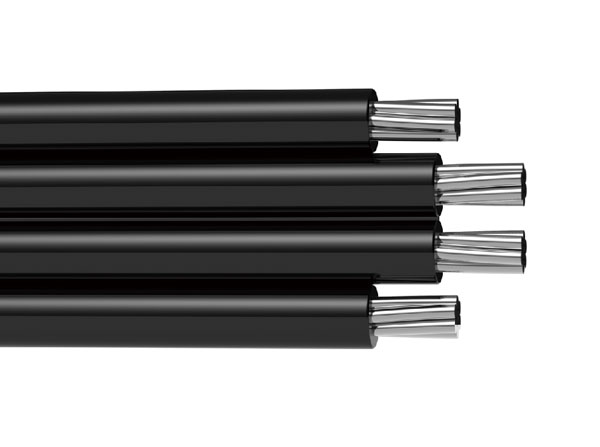
Structure and material of cable products
The structural elements of wire and cable products can generally be divided into four main structural components: conductor, insulation layer, shield and sheath, as well as filling elements and tension bearing elements. According to the use requirements and application occasions of products, some products are extremely simple in structure, with only one structural part of conductor, such as overhead bare conductor, catenary conductor, copper aluminum bus bar (bus), etc; The external electrical insulation of these products is ensured by using insulators and space distance (that is, air insulation) during installation and laying.
1、 Structure and composition of cable products
The vast majority of wire and cable products are products with identical cross section (cross section) shape (ignoring the error caused by manufacturing) and long strip shape, which is determined by the characteristics used to form circuits or coils in systems or equipment. Therefore, to study and analyze the structural composition of cable products, we only need to observe and analyze from its cross section.
The structural elements of wire and cable products can generally be divided into four main structural components: conductor, insulation layer, shield and sheath, as well as filling elements and tension bearing elements. According to the use requirements and application occasions of products, some products are extremely simple in structure, with only one structural part of conductor, such as overhead bare conductor, catenary conductor, copper aluminum bus bar (bus), etc; The external electrical insulation of these products is ensured by using insulators and space distance (that is, air insulation) during installation and laying.
1. Conductor
The conductor is the most basic and essential main component for the product to transmit current or electromagnetic wave information. Conductor is the abbreviation of conductive wire core, which is made of nonferrous metals with excellent conductivity such as copper and aluminum. Optical fiber cables for optical communication networks, which have developed rapidly over the past three decades, use optical fiber as the conductor.
2. Insulation layer
It is a component that is wrapped around the periphery of the conductor and plays the role of electrical insulation. That is to say, it can ensure that the transmitted current, electromagnetic wave and light wave only travel along the conductor and do not flow outward, and the potential on the conductor (that is, the potential difference formed on the surrounding objects, that is, the voltage) can be isolated, that is, it is necessary to ensure both the normal transmission function of the conductor and the safety of external objects and people.
The conductor and insulation layer are two basic components that must be possessed by cable products (except bare wires).
3. Sheath
When wire and cable products are installed and operated in various environments, they must have components that protect the whole product, especially the insulation layer, which is called protective layer.
Because insulating materials are required to have excellent electrical insulation properties, they must have very high purity and very low impurity content; It is often impossible to give consideration to its ability to protect the outside world, so the bearing or resistance of various mechanical forces to the outside world (i.e., installation, application and use), resistance to atmospheric environment, chemicals or oils, prevention of biological damage, and reduction of fire hazards must be borne by various protective layer structures.
Many cable products dedicated to good external environment (such as clean, dry, indoor without external mechanical force), or products with insulating layer materials that have certain mechanical strength and weather resistance, can have no protective layer.
4. Shielding
It is a component that isolates the electromagnetic field in the cable product from the external electromagnetic field; The cable products of are also required to be isolated from each other between different pairs (or groups) of wires inside. It can be said that the shielding layer is an "electromagnetic isolation screen".
For many years, the industry has been accustomed to taking the shielding layer as a part of the sheath structure, and the author believes that it should be taken as a component alone. The reason is that the function of the shielding layer is electromagnetic isolation - that is, the information transmitted in the cable product does not leak out, and does not interfere with external instruments or other lines; Various external electromagnetic waves will not enter the cable products through electromagnetic coupling, and these functional requirements are different from the traditional protective layer functions. It is also because the shielding layer is not only set outside the product, but also between the groups of each single pair or multi pair cable. In recent decades, with the rapid development of wires and cables for information transmission systems, and the increasing number of electromagnetic interference sources in the atmosphere, the variety of shielding structures has multiplied. Everyone's understanding of the shielding layer as a basic component of cable products has tended to be recognized.
5. Filling structure
Many wire and cable products are multi-core, such as low-voltage power cable Most of them are four core and five core cables (applicable to three-phase systems), and there are 800 pairs, 1200 pairs, 2400 pairs to 3600 pairs of local telephone cables. After these insulated wire cores or wire pairs are cabled (or cabled in groups for many times), the first reason is that the shape is not round, and the second reason is that there is a large gap between the insulated wire cores (see Figure 1). Therefore, the filling structure must be added when cabling. The filling structure is to make the outer diameter of the cable relatively round to facilitate tape wrapping and sheath extrusion, as well as to make the cable structure stable and internal stones, In use (when stretching, compressing and bending during manufacturing and laying), the force shall be uniform without damaging the internal structure of the cable.
Fig. 1 Schematic Diagram of Clearance of 2-4-core Low voltage Power Cable during Cabling
Therefore, although the filling structure is an auxiliary structure, it is also necessary, and its material selection and shape design are also specified in detail.
6. Tension element
The traditional wire and cable products use the armor layer of the sheath to bear the external tension or the tension caused by the dead weight. The typical structure is steel tape armor and steel wire armor (such as submarine cable ф 8mm thick steel wire, twisted to form armor layer). However, in order to protect the optical fiber from small tensile force and prevent the optical fiber from being slightly deformed and affecting the transmission performance, primary and secondary coating and special tensile stress components are set in the optical fiber cable structure. In addition, for example, the earphone cable of mobile phone adopts the structure of thin copper wire or thin copper tape wrapped on synthetic fiber wire to extrude the insulation layer, and the synthetic fiber wire is a tensile element. In a word, the tension element plays a major role in the special small and soft products developed in recent years that require multiple bending and twisting.
2、 Summary of materials for wires and cables
1. In a sense, wire and cable manufacturing industry is a material finishing and assembly industry. First, the material consumption is huge, and the material cost of cable products accounts for 60-90% of the total manufacturing cost; Second, there are many types and varieties of materials used, and the performance requirements are particularly high. For example, copper used as conductor, the purity of copper is required to be above 99.95%, and some products should use oxygen free high-purity copper; Third, the selection of materials will have a decisive impact on the manufacturing process, product performance and service life.
At the same time, the benefits of cable manufacturing enterprises are also closely related to the scientific material saving in material selection, processing and production management.
Therefore, the design of wire and cable products must be carried out at the same time as the selection of materials. Generally, several materials are selected and determined after the process and performance screening tests.
2. The materials used for cable products can be divided into conductive materials, insulating materials, sheath materials, shielding materials, filling materials, etc. according to their use positions and functions. However, some of the materials are common to several structural parts, such as copper wire and copper tape for shielding, which are also electrical copper for conductors. In particular, thermoplastic materials, such as polyvinyl chloride and polyethylene, can be used on insulation or sheath as long as some formula components are changed.
3. The materials used in the manufacture of cable products cover a wide range of categories, and there are many varieties and specifications (brands).
4. Due to the ever-changing use functions, application environment and use conditions of cable products, although there are basic performance requirements (generality) for a certain type of material, there are some special performance requirements (characteristics) for each series and variety of products. For example, the common requirement for the insulation layer of wires and cables used in power system is high electrical insulation performance. For example, for high-voltage power cables, it must be emphasized that the materials can withstand high electric field strength, have high insulation resistance, require low dielectric loss, and require that there are almost no impurities (including air gap) in the insulation layer. and Medium voltage power cable (6-35kv) has these requirements, but the degree can be reduced. As for low-voltage wires and cables, only a certain withstand voltage strength and insulation resistance are required. For the sake of economy and portability, the insulation layer is required to have good mechanical property and weather resistance, so that in many cases it can be without protective layer (such as PVC plastic insulated wires).
5. Because materials play a very important role in the performance of products, and because many categories of materials involve a wide range of knowledge fields, materials with the same name have many brands and formulas due to different molecular structures and molecular weight distributions of the base materials, different ingredients and different proportions of mixtures. The result is that the process conditions of various brands of materials are different, and the properties of finished products after manufacturing are very different. Therefore, cable manufacturing enterprises must require production workers to be familiar with the characteristics of common materials in this process, strictly implement the process operating procedures, and require inspection departments to strengthen the strict quality control of incoming materials and self prepared materials.
Shandong Peninsula cable is professional Overhead insulated cable Manufacturer, absolute quality assurance.














